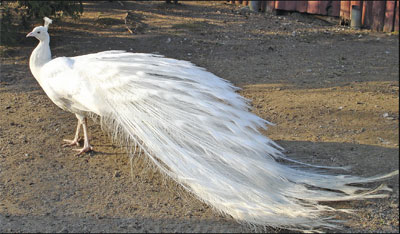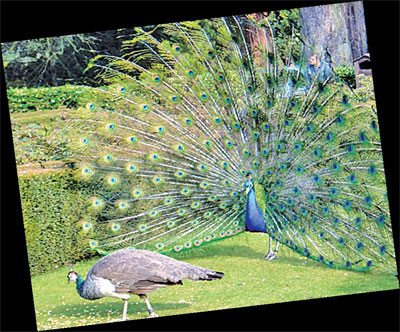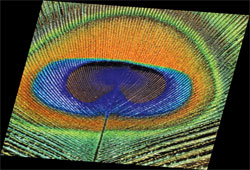|
Peacocks:
Impressive feathered beauties
The avian world is full of feathered beauties that mesmerize us with
their vibrantly hued plumage and their melodious calls.And so it may
prove difficult to rank these birds on a 1-10 scale since many of us
would have our own preferences when it comes to selecting the most
attractive birds. However, the male peafowl or the peacock as it is
popularly called is sure to be placed high in the scale due to its
beautiful fan-like tail.
 Most
of you may have seen the peacock proudly strut and dance displaying its
captivating tail feathers of iridescent hues that change and shimmer in
the light .These tail feathers, or coverts, spread out in a distinctive
train which is more than 60 per cent of the bird's total body length . Most
of you may have seen the peacock proudly strut and dance displaying its
captivating tail feathers of iridescent hues that change and shimmer in
the light .These tail feathers, or coverts, spread out in a distinctive
train which is more than 60 per cent of the bird's total body length .
They are adorned with colourful "eye" markings of blue, gold, red,
and other hues.Even if you have not seen this eye catching display you
are sure to have seen the beautiful peacock feathers which are used in
many religious rituals, especially at Kataragama.
Many of you may have seen these impressive feathered beauties or at
least heard of them but you may not know many details about them. So,
today let's enhance your knowledge about this species of bird called the
peafowl which belongs to the pheasant family. There are three species of
peafowl; Indian peafowl or Blue peafowl (Pavo cristatus) which is native
to South Asia, but has been introduced and is semi-feral in many other
parts of the world , the Green peafowl and the Congo peafowl.
There are several colour mutations of Indian peafowl. These very
rarely occur in the wild, but selective breeding has made them common in
captivity. The leucistic white peafowl and the Black-shouldered or
Japanned mutation were initially considered as a subspecies.
|

A peacock displays its fan-like tail. |
|

The leucistic white peafowl |
The blue peacock lives in India and Sri Lanka, while the green
peacock is found in Java and Myanmar (Burma).The more distinct and
little-known species, the Congo peacock, inhabits African rain
forests.The Congo peafowl is listed by the International Union for
Conservation of Nature (IUCN) as 'vulnerable .' - (At risk because of
their natural declining numbers) are facing high-risk in their natural
surroundings. The Green peafowl is listed as 'endangered'. - In the
immediate probability of becoming extinct and require protection to
exist.
A male peafowl is called a peacock and the female a peahen but the
term peacock is commonly used to refer to both species by many. The male
(peacock) Indian peafowl has iridescent blue-green or green coloured
plumage; metallic blue on the crown, the feathers of the head being
short and curled. The fan-shaped crest on the head is made of feathers
with bare black shafts and tipped with blush-green webbing. A white
stripe above the eye and a crescent shaped white patch below the eye are
formed by bare white skin. The sides of the head have iridescent
greenish blue feathers. The back has scaly bronze-green feathers with
black and copper markings. The scapular and the wings are buff and
barred in black, the primaries are chestnut and the secondaries are
black. The tail is dark brown and the "train" is made up by elongated
upper tail coverts (more than 200 feathers but the actual tail has only
20 feathers) and nearly all of these feathers end with an elaborate
eye-spot. A few of the outer feathers lack the spot and end in a
crescent shaped black tip. The underside is dark glossy greenshading
into blackish under the tail. The thighs are buff coloured. The male has
a spur on the leg above the hind toe.
The peahen is very dowdy compared to the peacock ,with mottled brown
feathers .The feathers have a mixture of dull green, brown, and grey.
She lacks the long upper tail coverts of the male which has earned him
great fame. The adult peahen has a rufous-brown head with a crest as in
the male but the tips chestnut edged with green. The upper body is
brownish with paler mottling. The primaries, secondaries and tail are
dark brown. The lower neck is metallic green and the breast feathers are
dark brown glossed with green. The rest of the underparts are whitish.
Downy young are pale buff with a dark brown mark on the nape connecting
with the eyes.Young males looks like the females but the wings are
chestnut coloured The female can also display her plumage to ward off
female competition or signal danger to her young.
Both males and females have a crest atop the head. However the crests
of peacocks differ according to the species:Indian and Green peacocks
have a crest made of feathers arranged in a fan shape,the Indian
peafowl's crest looks like little dots on the end of sticks and the
Congo peafowl has vertical white elongated hair-like feathers on its
crown . Indian peafowl are widely distributed in the wild across South
Asia and protected in many areas.

A peahen |

A peacock dances near a peahen |
The peacock's large train is said to be used in mating rituals and
courtship displays. It can be arched into a magnificent fan that reaches
across the bird's back and touches the ground on either side.Females are
believed to choose their mates according to the size, colour, and
quality of their outrageous feather trains.Suitable males may gather
harems of several females, each of which will lay three to five eggs.
When a male is displaying its tail feathers females do not appear to
show any interest and usually continue their foraging.The peak season in
southern India to see the peacock display its fan-like tail is April to
May and June in northern India. In Sri Lanka we can see the peacok dance
to attract a mate from January to March .When it is time to reproduce
the peahen builds a nest that is a shallow scrape in the ground lined
with leaves, sticks and other debris. Nests are sometimes placed on
buildings and in earlier times the peahens have been recorded using the
disused nest platforms of the White-rumped Vultures. The clutch consists
of 4-8 fawn to buff white eggs which are incubated only by the female.
The eggs take about 28 days to hatch. Downy young may sometimes climb on
their mother's back and the female may carry them in flight to a safe
tree branch.
The Green peafowl appears different from the Indian peafowl. The male
has green and gold plumage and has an erect crest. The wings are black
with a sheen of blue. Unlike the Indian peafowl, the Green peahen is
similar to the male, only having shorter upper tail coverts and less
iridescence. It is difficult to tell a juvenile male from an adult
female.
|

A peahen with chicks |
Indian and Green peacocks have bare patches of skin around their
eyes. The peafowl in general are forest birds that nest on the ground
but roost in trees;they will fly up into tall trees to roost In fact,
wild peafowl often roost in forest trees and gather in groups called
parties.They are omnivorous and eat most plant parts, flower petals,
seed heads, insects and other arthropods, reptiles, and amphibians.
Generally they are known to bet terrestrial feeders. They are found
mainly on the ground in open forest or cultivation where they forage for
berries, grains but will also prey on snakes, lizards, and small
rodents. They move in in small groups when foraging and will usually try
to escape on foot through undergrowth and avoid flying. They are fond of
dust-bathing and at dusk, groups walk in single file to a favourite
waterhole to drink. When disturbed, they usually escape by running and
rarely take to flight. Their loud calls make them easy to detect, and in
forest areas, often indicate the presence of a predator such as a
tiger.Nearly seven different call variants have been identified in the
peacocks apart from six alarm calls that are commonly produced by both
sexes.
The male peafowl is a large bird with a length from bill to tail of
100 to 115 cm (40 to 46 inches) and to the end of a fully grown train as
much as 195 to 225 cm (78 to 90 inches).It weighs 4-6 kg (8.8-13.2 lbs).
The females, or peahens, are smaller at around 95 cm (38 inches) in
length and weigh 2.75 - 4 kg (6-8.8 lbs) They are highly sociable
creatures and require companionship. Males generally have a harem of 2 -
5 females.
|

A close up of the eye of the feather |
Adult peafowl can usually escape ground predators by flying into
trees. Leopards are able to ambush them however, Foraging in groups
provides some safety as there are more eyes to look out for
predators.They are sometimes hunted by large birds of prey such as the
Crested Hawk-Eagle and Rock Eagle-owl. Chicks are prone to predation.
Adults living near human habitations are sometimes hunted by domestic
dogs or by humans in some areas .
In captivity, birds have been known to live for 23 years but it is
estimated that they live for only about 15 years in the wild. Prominent
in many cultures, the peacock has been used in numerous iconic
representations, including being designated the national bird of India
in 1963.
The peacock, known as Mayura in Sanskrit, has enjoyed a fabled place
in India since and is frequently depicted in temple art, mythology,
poetry, folk-music and traditions.In our country too the peacock is
greatly admired for its beauty and also given pride of place at
Kataragama.
Fact file:
* Technically, only males are peacocks. Females are peahens, and
together, they are called peafowl.
* The peacock tail ("train") is not the tail quill feathers but the
highly elongated upper tail coverts.
* Like a cupped hand behind the ear the erect tail-fan of the male
helps direct sound to the ears.

* Seven year study of free living peacocks, conducted in Japan came
to the conclusion that female peahens are virtually indifferent towards
the male display of plumage.
* In Hinduism, the Peacock is associated with Saraswati, a deity
representing benevolence, patience, kindness, compassion and knowledge.
Peacock is also the mount of Hindu God of war Murugan. The peacock is
the steed of Kartikay, the brother of Ganesha.
* In Greco-Roman mythology the peacock is identified with the goddess
Hera (Juno). The eyes upon the peacock's tail comes from Argus whose
hundred eyes were placed upon the peacock's feathers by the goddess in
memory of his role as the guard of Io, a lover of Zeus that Hera had
punished. The eyes are said to symbolise the vault of heaven and the
"eyes" of the stars.
* In Babylonia and Persia the peacock is seen as a guardian to
royalty, and is often seen in engravings upon the thrones of royalty.
*In some cultures the peacock is also a symbol of pride or vanity,
due to the way the bird struts and shows off its plumage.
* Only a peacock (male peafowl) has a colorful train.
* The collective name for a group of peahens is a harem while the
collective name for a group of males is a party. A family of peacocks is
called a bevy. The names given to babies are chicks.
*The Latin genus name Pavo and the Anglo-Saxon Pawe (from which the
word "Peacock" is derived) are believed to be echoic in their origin and
based on the usual call of the bird. The species name cristatus refers
to the crest.
*The earliest usage of the word in written English is from around
1300 and has spelling variants . The current spelling was established in
the late 17th century.
* It was Chaucer (1343â€"1400 who ) used the word to refer to a proud
and ostentatious person in his simile "proud a pekok"(A spelling
variant) in Troilus and Criseyde (Book I, line 210)
|

